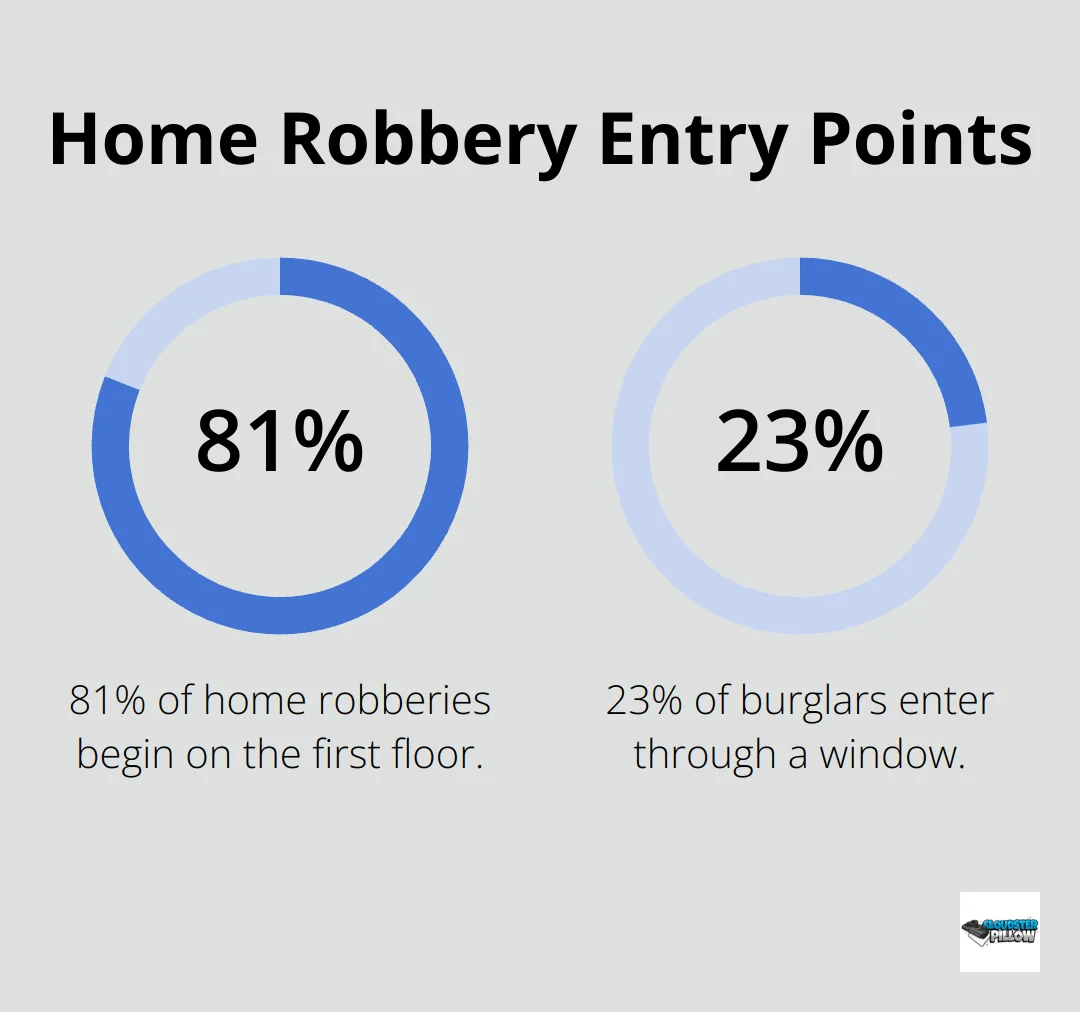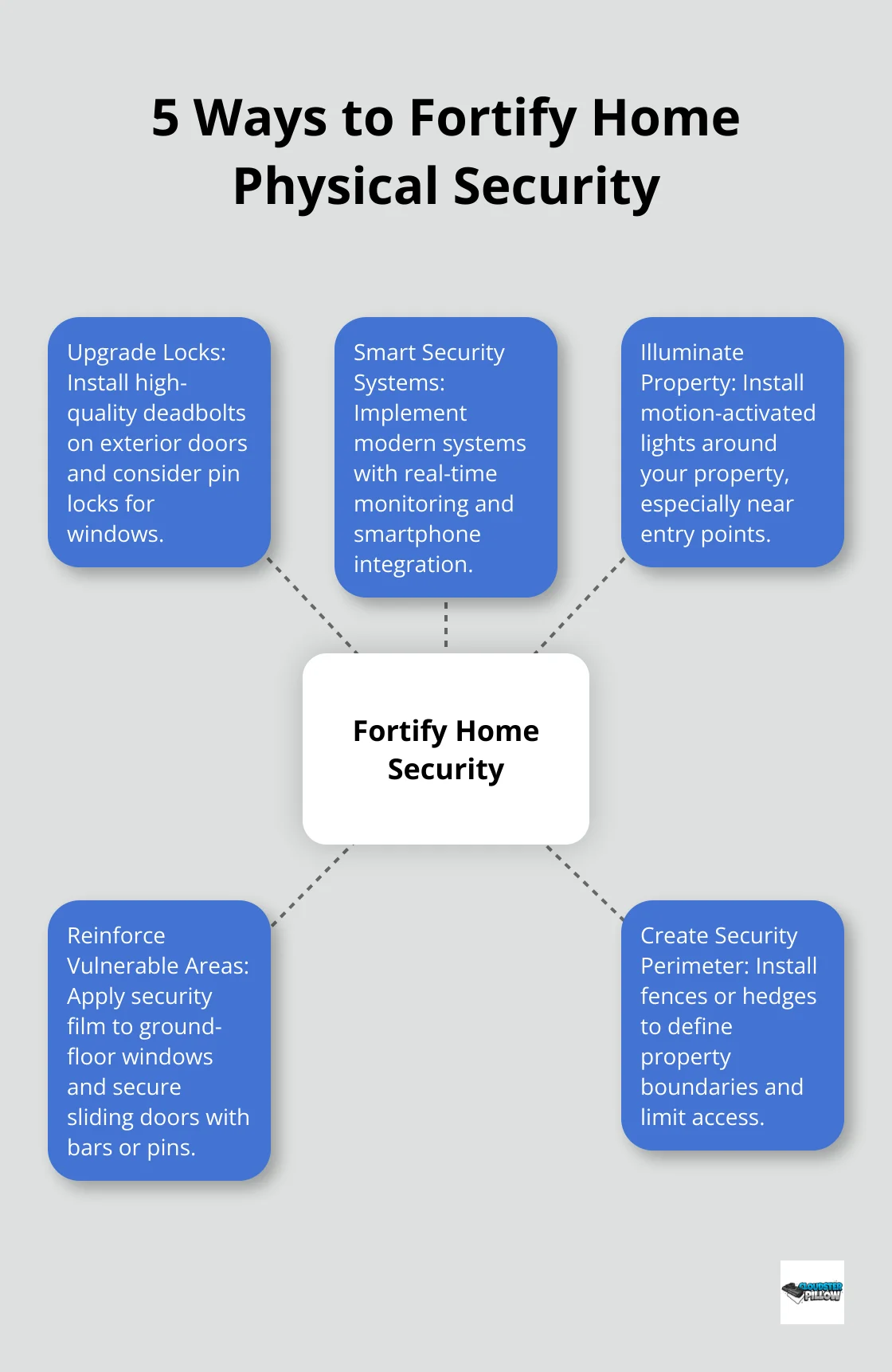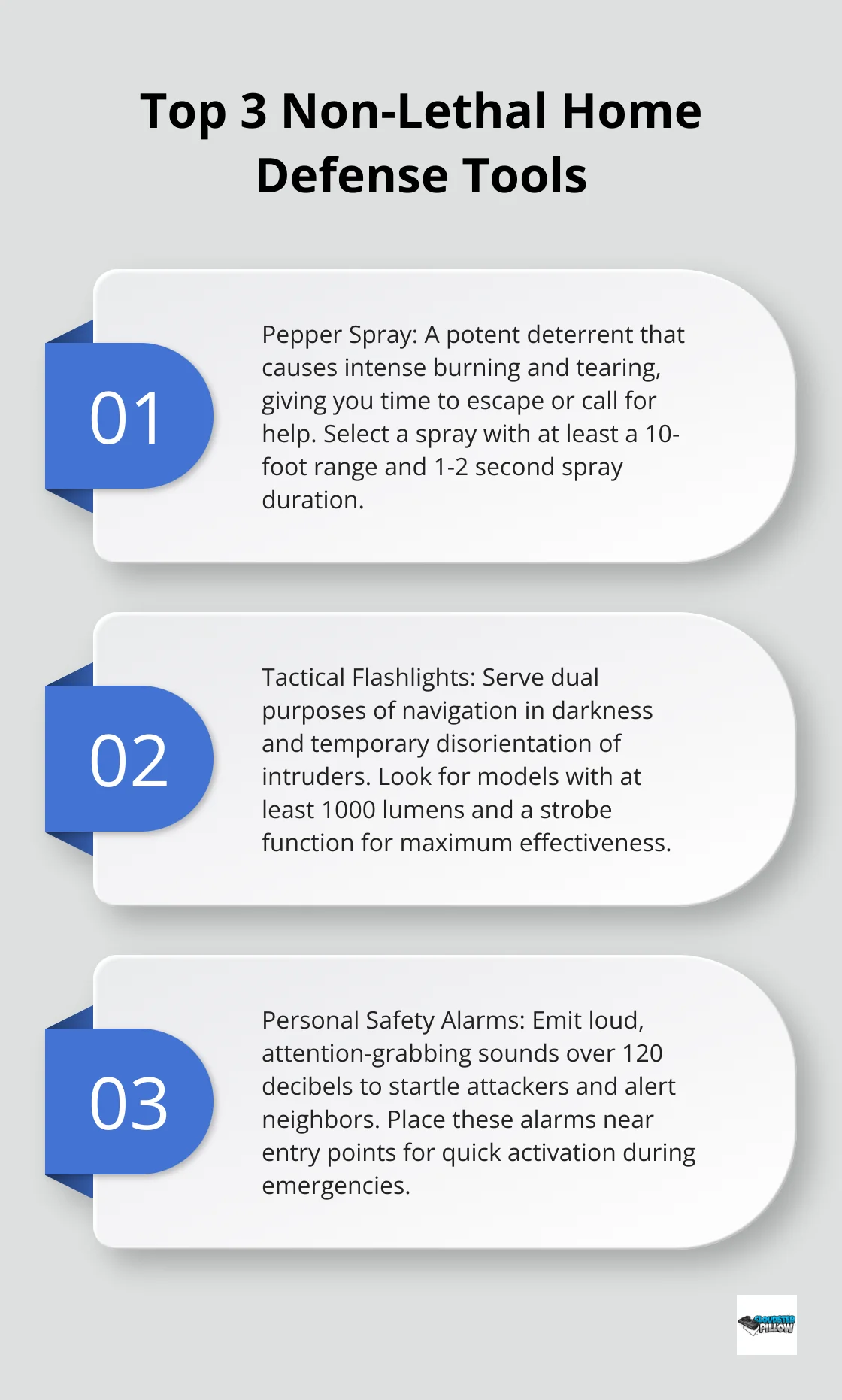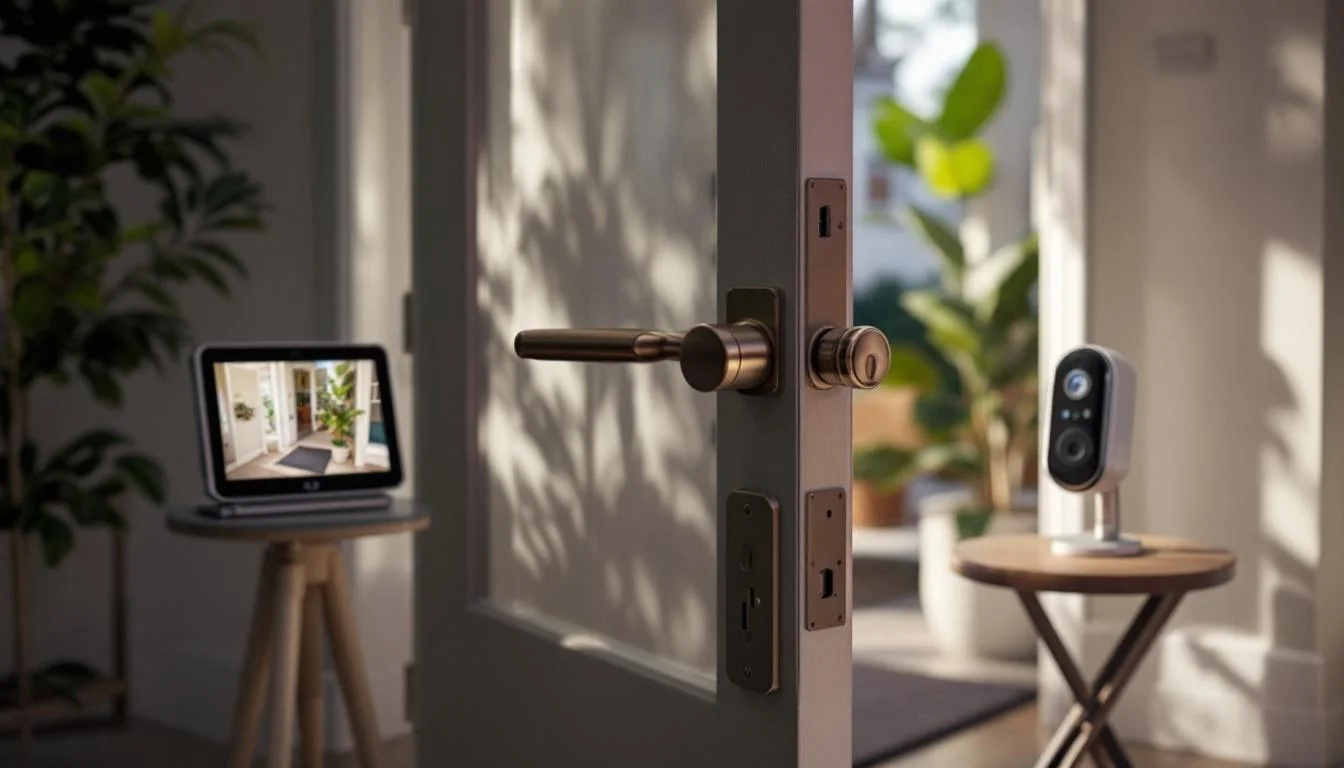Home Defense
Essential Home Defense Strategies for Your Family’s Safety
At Cloudster Pillow, we understand that a good night’s sleep starts with feeling safe in your own home. Home defense is a critical aspect of family security that every household should prioritize.
This guide will walk you through essential strategies for home defense to protect your loved ones and property from potential threats. We’ll cover everything from creating a solid defense plan to exploring non-lethal options for safeguarding your home.
How to Create an Effective Home Defense Plan
Identify Weak Points in Your Home
Home Defense starts with a walk through of your property with a critical eye. Look for easy entry points like ground-floor windows or poorly lit areas. 81% of home robberies begin on the first floor, with 23% of burglars entering through a window. Focus on these areas and consider reinforcing them with stronger locks or security film.

Designate Safe Zones
Your home needs at least one safe room where family members can retreat during an emergency. This room should have a sturdy door, a phone line, and provisions. FEMA defines a safe room as a hardened structure specifically designed to provide near-absolute protection in extreme events.
Establish Clear Communication
Clear communication can make all the difference in high-stress situations. Develop a simple set of code words or phrases that all family members understand. For example, “Code Red” could mean “lock yourself in the safe room immediately.” Practice these phrases regularly so they become second nature.
Run Regular Drills
Home defense drills are as important as fire drills for preparedness. Practice sessions should be conducted regularly. Time how long it takes for everyone to reach the safe room. Discuss what went well and what needs improvement after each drill.
Update Your Plan Regularly
A good plan evolves. As your family grows and your home changes, so should your defense strategy. Try to review and update your plan at least twice a year (spring and fall are good times to do this). This regular review will help you foster a culture of safety and preparedness in your household.
Now that you have a solid foundation for your home defense plan, let’s move on to enhancing the physical security measures of your property. These practical steps will add layers of protection to your home and deter potential intruders.
How to Fortify Your Home’s Physical Security
Physical security forms the foundation of home defense. A secure home leads to better sleep and peace of mind. Let’s explore practical ways to enhance your home’s physical defenses.

Upgrade Your Locks
Start with your doors. Install high-quality deadbolts on all exterior doors. The American National Standards Institute (ANSI) rates locks from Grade 1 (strongest) to Grade 2, with Grade 1 offering the highest protection and Grade 2 balancing security with other factors. Choose Grade 1 deadbolts for maximum security. For windows, consider pin locks or key-operated locks. These simple upgrades will significantly deter break-ins.
Implement Smart Security Systems
Modern security systems offer more than just alarms. They provide real-time monitoring, smartphone integration, and even facial recognition. A study by the University of North Carolina at Charlotte found that the presence of alarm systems impacts residential burglaries. Popular options include Ring, SimpliSafe, and ADT (choose a system that fits your budget and needs).
Illuminate Your Property
Proper lighting acts as a powerful deterrent. Install motion-activated lights around your property, especially near entry points. The International Dark-Sky Association recommends warm-white LEDs (CCT < 3,000 K) to reduce glare and light pollution while maintaining visibility. Use fully shielded fixtures that emit no light upward. Smart bulbs that you can control remotely add an extra layer of security when you’re away from home.
Reinforce Vulnerable Areas
Don’t overlook your home’s weak points. Apply security film to ground-floor windows to make them harder to break. Use a security bar or pin for sliding doors to prevent forced entry. If you have a garage, secure the door connecting it to your house as well as your front door. A chain is only as strong as its weakest link, so address all potential entry points.
Create a Security Perimeter
Extend your security beyond the walls of your home. Install fences or hedges to define property boundaries and limit access. Use thorny plants under windows as a natural deterrent. Consider adding cameras or motion sensors to monitor your yard and driveway. These measures create multiple layers of security, making your property less attractive to potential intruders.
Now that we’ve covered physical security measures, let’s explore non-lethal options to complement these defenses. These tools provide additional protection without the risks associated with lethal force.
Non-Lethal Home Defense Tools

Pepper Spray: A Potent Deterrent
Pepper spray provides an effective self-defense option without lethal consequences. The active ingredient, oleoresin capsicum, causes intense burning and tearing, which gives you time to escape or call for help. Select a pepper spray with a range of at least 10 feet and a spray duration of 1-2 seconds. The SABRE Red Pepper Gel offers an 18-foot range and up to 18 bursts.
Place pepper spray in easily accessible locations throughout your home (out of children’s reach). Use it indoors or in enclosed spaces for best results, as wind can affect its effectiveness.
Tactical Flashlights: Illumination and Defense
High-lumen tactical flashlights serve two purposes: navigation in darkness and temporary disorientation of intruders. Look for models with at least 1000 lumens and a strobe function. The Fenix PD36R boasts 1600 lumens and can operate for up to 115 hours on a single charge.
Position tactical flashlights strategically near entry points and in bedrooms. Train your family to use the strobe function effectively – a quick burst of intense light can provide valuable seconds in a confrontation.
Personal Safety Alarms: The Power of Noise
Noise acts as a powerful deterrent to intruders. Personal safety alarms emit a loud, attention-grabbing sound that can startle an attacker and alert neighbors. Many models produce sounds over 120 decibels (louder than a car horn at close range).
Alarm systems are a proven deterrent to burglars, significantly reducing the risk of a break-in. The KOSIN Safe Sound Personal Alarm emits a 140dB siren and comes in a pack of six. Place these alarms near entry points and teach family members how to activate them quickly. The sudden, piercing noise can make an intruder reconsider their actions.
Home Security Dogs: Natural Guardians
Dogs provide an additional layer of home security. Their keen senses can alert you to potential threats before you notice them. Large breeds like German Shepherds or Rottweilers can intimidate intruders, while smaller breeds like Chihuahuas or Jack Russell Terriers make excellent alarm systems.
Train your dog to respond to specific commands and situations. A well-trained dog can bark on command, alerting neighbors and deterring intruders. However, never rely solely on a dog for home defense – they should complement other security measures.
Self-Defense Training: Empowering Your Family
Invest in self-defense training for all family members. Techniques like situational awareness, de-escalation, and basic physical defense can increase confidence and preparedness. Look for local classes that focus on practical, real-world scenarios.
Regular practice ensures these skills become second nature. Create a family training schedule and incorporate self-defense drills into your overall home security plan. This proactive approach empowers everyone to contribute to the family’s safety. Self-defense training can be practiced at home, equipping you with knowledge and strategies for personal safety.
FAQs
What should be included in a home defense plan?
A good home defense plan includes identifying weak points in your home, such as poorly lit areas and easy entry points, and reinforcing them. It should also designate safe zones, such as a secure room, and establish clear communication protocols with code words for emergencies. Regular drills should be conducted to ensure all family members can act quickly and effectively in case of an emergency. Regular updates to the plan will ensure it remains relevant to any changes in the household or environment.
How can I fortify my home’s physical security?
To fortify your home’s physical security, start with upgrading your locks to Grade 1 deadbolts, especially on exterior doors. Implement a smart security system that includes real-time monitoring, smartphone integration, and even facial recognition. Install motion-activated lights to illuminate entry points and reinforce vulnerable areas like windows and sliding doors with security film or bars. Creating a security perimeter with fences, hedges, and outdoor cameras or motion sensors adds multiple layers of protection around your property.
What non-lethal home defense tools are effective?
Effective non-lethal home defense tools include:
- Pepper Spray: Causes intense burning and tearing, giving you time to escape or call for help. Choose one with a range of at least 10 feet.
- Tactical Flashlights: High-lumen flashlights (1000+ lumens) with a strobe function help disorient intruders and aid in visibility during dark hours.
- Personal Safety Alarms: Emit a loud sound (over 120dB) to startle an intruder and alert neighbors, acting as a deterrent.
How can a home defense dog contribute to my family’s safety?
Dogs offer an additional layer of home security with their keen senses and natural ability to alert you to potential threats. Larger breeds like German Shepherds or Rottweilers can be intimidating to intruders, while smaller breeds like Chihuahuas or Jack Russell Terriers make excellent alarm systems. Training your dog to respond to commands can enhance their effectiveness, but dogs should always complement other security measures like locks, alarms, and surveillance systems.
Why is self-defense training important for family safety?
Self-defense training empowers all family members to respond confidently and effectively in dangerous situations. It includes teaching situational awareness, de-escalation techniques, and basic physical defense. Regular practice ensures these skills become second nature. Creating a family training schedule and incorporating self-defense drills into your home security plan helps prepare everyone to act in emergencies. This proactive approach increases overall family safety and preparedness.
Final Thoughts
Home defense requires a comprehensive strategy that includes vulnerability assessment, safe zone establishment, and clear communication protocols. Physical security measures such as upgraded locks, smart systems, and strategic lighting create a robust barrier against potential threats. Non-lethal tools like pepper spray, tactical flashlights, and personal alarms add extra layers of protection without the risks associated with lethal force.
An effective home defense plan must adapt to changing family needs and circumstances. Regular reviews and bi-annual drills help maintain preparedness and identify areas for improvement. The goal is to create a secure environment that doesn’t feel oppressive, balancing safety with everyday life.
For those who carry concealed firearms, comfort is essential for consistent and effective carry. The Cloudster Pillow enhances comfort and concealment, particularly for inside-the-waistband or appendix holsters. Its design reduces pressure points and improves firearm concealment (making it a valuable accessory for everyday carry).


Pingback: What to Expect in a Concealed Carry Class - Cloudster Pillow
Pingback: Best Home Defense Weapons Non-Lethal - Cloudster Pillow